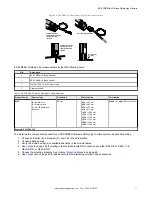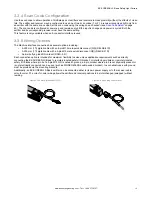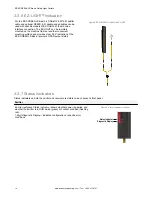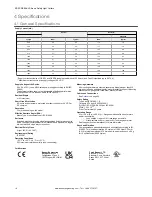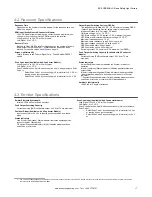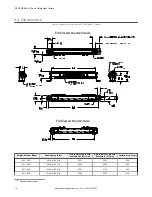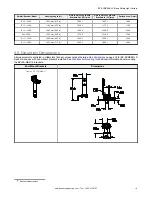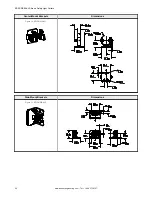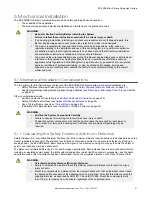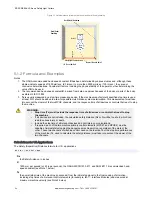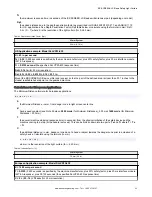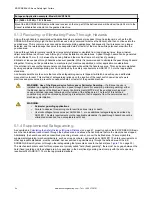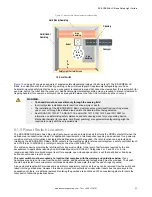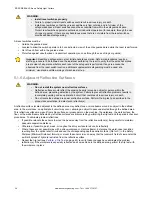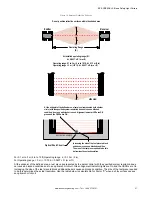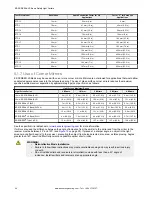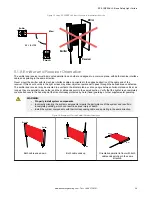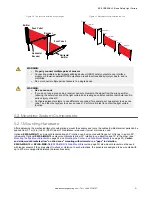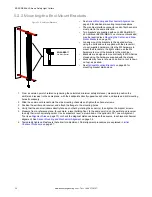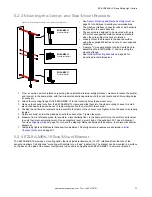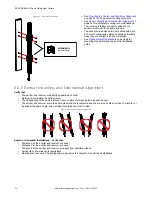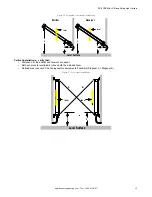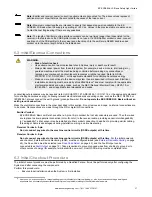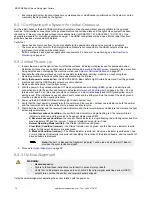
European Application example: Model SLLVP23-630
S = (1600 × 0.3325) + 72 = 604 mm
Mount the EZ-SCREEN LS Basic emitter and receiver so that no part of the defined area will be closer than 604 mm to the
closest reachable hazard point on the guarded machine.
5.1.3 Reducing or Eliminating Pass-Through Hazards
A
pass-through
hazard is associated with applications where personnel may pass through a safeguard, such as the EZ-
SCREEN LS Basic Safety Light Curtain (which issues a stop command to remove the hazard), and then continues into the
guarded area. This is common in access and perimeter guarding applications. Subsequently, their presence is no longer
detected, and the related danger becomes the unexpected start or restart of the machine while personnel are within the
guarded area.
A pass-through hazard typically results from large safety distances calculated from long stopping times, large minimum
object sensitivities, reach-over, reach-through, or other installation considerations. A pass-through hazard can be generated
with as little as 75 mm (3 in) between the sensing field and the machine frame or hard (fixed) guarding.
Eliminate or reduce pass-through hazards whenever possible. While it is recommended to eliminate the pass-through hazard
altogether, this may not be possible due to machine layout, machine capabilities, or other application considerations.
One solution is to ensure that personnel are continually sensed while within the hazardous area. This can be accomplished
by using supplemental safeguarding, such as described by the safety requirements in ANSI B11.19 or other appropriate
standards.
An alternative method is to ensure that once the safeguarding device is tripped it will latch and will require a deliberate
manual action to reset. This method of safeguarding relies upon the location of the reset switch as well as safe work
practices and procedures to prevent an unexpected start or restart of the guarded machine.
WARNING: Use of the Banner device for Access or Perimeter Guarding
— If a Banner device is
installed in an application that results in a pass-through hazard (for example, perimeter guarding), either
the Banner device or the Machine Primary Control Elements (MPCEs) of the guarded machine must
cause a Latched response following an interruption of the defined area. The reset of this Latched
condition may only be achieved by actuating a reset switch that is separate from the normal means of
machine cycle initiation.
WARNING:
•
Perimeter guarding applications
•
Failure to observe this warning could result in serious injury or death.
•
Use lockout/tagout procedures per ANSI Z244.1, or use additional safeguarding as described by
ANSI B11.19 safety requirements or other applicable standards if a passthrough hazard cannot be
eliminated or reduced to an acceptable level of risk.
5.1.4 Supplemental Safeguarding
Calculating the Safety Distance (Minimum Distance)
on page 21, properly position the EZ-SCREEN LS Basic
such that an individual cannot reach through the defined area and access the hazard point before the machine has stopped.
Additionally, the hazard cannot be accessible by reaching around, under, or over the defined area. To accomplish this,
supplemental guarding (mechanical barriers, such as screens or bars), as described by ANSI B11.19 safety requirements or
other appropriate standards, must be installed. Access will then be possible only through the defined area of the EZ-
SCREEN LS Basic System or through other safeguarding that prevents access to the hazard (see
on page 25).
The mechanical barriers used for this purpose are typically called "hard (fixed) guarding"; there must be no gaps between the
hard (fixed) guarding and the defined area. Any openings in the hard (fixed) guarding must comply with the safe opening
requirements of ANSI B11.19 or other appropriate standard.
EZ-SCREEN
®
LS Basic Safety Light Curtain
24
www.bannerengineering.com - Tel: + 1 888 373 6767


